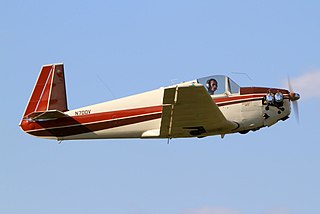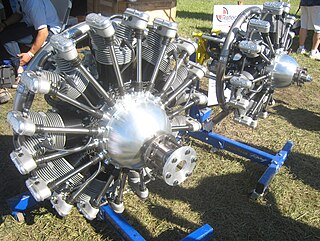
The Vought OS2U Kingfisher is an American catapult-launched observation floatplane. It was a compact mid-wing monoplane, with a large central float and small stabilizing floats. Performance was modest because of its low-powered engine. The OS2U could also operate on fixed, wheeled, taildragger landing gear.

The Beechcraft Model 17 Staggerwing is an American biplane with an atypical negative wing stagger. It first flew in 1932.

The Laird LC-DW300 and LC-DW500 Super Solution aka "Sky Buzzard" was a racing biplane built in the early 1930s by Matty Laird for the Cleveland Speed Foundation, Laird was already famous in the air racing circuit. It had a large radial engine and an extremely faired windshield. Other than being a biplane, it was similar in appearance to the Gee Bee, a more famous racer from the period. It was an advanced design for the time because of the relatively clean aerodynamic construction and tight engine cowling.

The Extra Flugzeugbau EA300 is a two-seat aerobatic monoplane capable of Unlimited category competition. It was designed in 1987 by Walter Extra, a German aerobatic pilot, and built by Extra Flugzeugbau.

The Pitts Special is a series of light aerobatic biplanes designed by Curtis Pitts. It has accumulated many competition wins since its first flight in 1944. The Pitts biplanes dominated world aerobatic competition in the 1960s and 1970s and, even today, remain potent competition aircraft in the lower categories.

The Gee Bee Model R Super Sportster was a special-purpose racing aircraft made by Granville Brothers Aircraft of Springfield, Massachusetts at the now-abandoned Springfield Airport. Gee Bee stands for Granville Brothers.

Curtis Hardeman Pitts was an American aircraft designer, aircraft manufacturer, crop duster, and airport fixed-base operator. He became widely known and revered in the aerobatics community for his design of the Pitts Special, a series of highly aerobatic biplanes. Pitts Specials dominated aerobatic competition from the 1960's to the 1970's. Though later outclassed by newer monoplane designs, Pitts Specials remain popular as sport airplanes for their excellent flying qualities. The Smithsonian Institution's National Air and Space Museum in Washington, DC has called Curtis Pitts' design "revolutionary because of its small size, light weight, short wingspan and extreme agility".

The Fokker G.I was a Dutch twin-engined heavy fighter aircraft comparable in size and role to the German Messerschmitt Bf 110. Although in production prior to World War II, its combat introduction came at a time the Netherlands were overrun by the Germans. The few G.Is that were mustered into service were able to score several victories. Some were captured intact after the Germans had occupied the Netherlands. The remainder of the production run was taken over by the Luftwaffe for use as trainers.

The Mooney M-18 "Mite" is a low-wing, single-place monoplane with retractable, tricycle landing gear.

The Silent Club is a single seater sailplane of Italian manufacture. It is of the FAI type DU Class glider. It is sold by Alisport ready-to-fly or kit-built as pure glider or self-launching glider. The self-launching version is fitted with a single-blade propeller belt-driven by a two-stroke engine or optionally by an electric motor.

The Christen Eagle, which later became the Aviat Eagle in the mid-1990s, is an aerobatic sporting biplane aircraft that has been produced in the United States since the late 1970s.

The Ikarus 451 is a family of research aircraft designs built in Yugoslavia in the 1950s, all sharing the same basic airframe, but differing in powerplants and cockpit arrangements. One member of the family Ikarus 451M became the first domestically-built jet aircraft to fly in Yugoslavia, on 25 October 1952.

The Supermarine Aircraft Spitfire is an American homebuilt aircraft produced in kit form by Supermarine Aircraft. A replica of the famous British Supermarine Spitfire World War II fighter, it was originally produced to 75% scale. Subsequent models have increased the scale of the fuselage and added a second seat.

The Rotec R3600 is a nine-cylinder radial engine built by Rotec Aerosport Pty Ltd in Australia. Initially released in 2005, it was a followup of the 7-cylinder Rotec R2800 released five years earlier. Both this engine and its smaller cousin have been frequently used as both replacement engines for vintage World War 1 aircraft, and reproduction aircraft from the same vintage. Some notable aircraft this engine has been used in are the Fokker Triplane, Sopwith Camel and the Nieuport 17.

The Short S.27 and its derivative, the Short Improved S.27, were a series of early British aircraft built by Short Brothers. They were used by the Admiralty and Naval Wing of the Royal Flying Corps for training the Royal Navy's first pilots as well as for early naval aviation experiments. An Improved S.27 was used by C.R. Samson to make the first successful take-off from a moving ship on 9 May 1912.

William Lewis "Skip" Stewart, better known as Skip Stewart, is an aerobatic and commercial pilot from the United States. Stewart flies in airshows in the United States and abroad, in his two highly modified Pitts muscle biplanes.
The Giles G-200 is an American aerobatic homebuilt aircraft that was produced by AkroTech Aviation of Scappoose, Oregon. When it was available the aircraft was supplied as a complete ready-to-fly-aircraft or a kit for amateur construction. The first customer-built aircraft made its first flight on May 26, 1996. AkroTech Aviation went out of business and the design is no longer in production.

The SkyDancer SD-260 was an American aerobatic homebuilt biplane that was designed and produced by SkyDancer Aviation of Louisville, Kentucky, introduced in the mid-1990s. When it was available the aircraft was supplied as a kit.
The Bradley BA-200 ATAC was an American homebuilt aircraft that was designed by Bradley Aerospace of Chico, California, introduced in the mid-1990s. The aircraft was intended to be supplied as a kit for amateur construction, but is likely that only one was constructed.

















